Fiano: Romano Clelia Colli di Lapio 2013 – Pairing Rating: 9.5 out of 10.0
Viognier: Yalumba Eden Valley, AU 2014 – Pairing Rating: 8.8
Sauvignon Blanc: Thomas LaBaille Sancerre Le Monts Damnés 2014 – Pairing Rating: 8.0
All right, all right, the sauce is really called Green Goddess. We thought if we used that old-school name you would never have opened this blog post. Too bad the big salad dressing companies dishonored this sauce with grocery store bottlings spiked with preservatives and artificial flavors.
It’s our understanding that Green Goddess originated at the Palace Hotel in San Francisco in 1923 when the hotel’s executive chef Philip Roemer wanted to pay tribute to actor George Arliss and his hit play, The Green Goddess. The recipe included anchovies, scallions, parsley, tarragon, mayonnaise, tarragon vinegar, and chives. Tarragon is clearly the dominant flavor here. Over time, variations emerged that included the additions of avocado, basil, even Worcestershire sauce.
Our intent with this post was to find a sauce for grilled salmon that didn’t involve butter. After all, butter-based sauces abound on the Internet and are often paired with Chardonnay or Pinot Noir. We wanted an alternative wine pairing for grilled salmon. The recipe below is quick to prepare and very close to the original, substituting lemon juice for the vinegar.
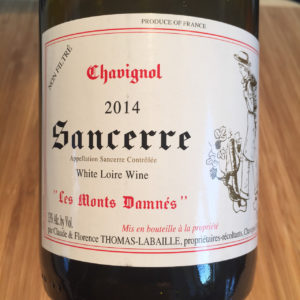 For the wine pairing, our first thought was to reach for a crisp, white wine like Sauvignon Blanc. We selected a 2014 Sancerre ($25) from Thomas-LaBaille’s Les Monts Damnés vineyard in the Loire village of Chavignol. The bottling is a beautiful expression of Sauvignon Blanc. The 2-3 years this wine spent in old oak barrels gave it a rich, layered mouthfeel; but the limestone soils of Chavignol endowed the citrusy flavors with a bit of an edge. We thought the acidity was too dominant and didn’t complement the sauce optimally.
For the wine pairing, our first thought was to reach for a crisp, white wine like Sauvignon Blanc. We selected a 2014 Sancerre ($25) from Thomas-LaBaille’s Les Monts Damnés vineyard in the Loire village of Chavignol. The bottling is a beautiful expression of Sauvignon Blanc. The 2-3 years this wine spent in old oak barrels gave it a rich, layered mouthfeel; but the limestone soils of Chavignol endowed the citrusy flavors with a bit of an edge. We thought the acidity was too dominant and didn’t complement the sauce optimally.
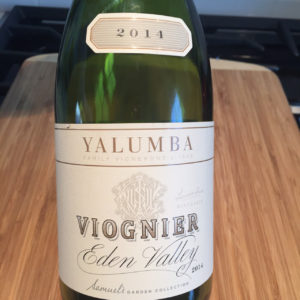 A better pairing in our view was Viognier. This Northern Rhone grape is now grown in California, Argentina, Australia and Washington State. Commonly used as a blending grape with Syrah (e.g. Côte Rôtie in the Northern Rhone), Viognier can now be readily found as a single varietal. It is appreciated for its opulent floral nose and vibrant palate of apricot, peach and pineapple. We chose a Viognier produced in the Eden Valley of South Australia: Yalumba 2014 ($20). In addition to the palate descriptors, some wine writers will also add that Viognier tastes of “steel”. And while we liked the nose and the creamy mouthfeel of the Yalumba Viognier, it was the steely edge that conflicted a bit with the sauce. We were getting closer to the right pairing, but still not there.
A better pairing in our view was Viognier. This Northern Rhone grape is now grown in California, Argentina, Australia and Washington State. Commonly used as a blending grape with Syrah (e.g. Côte Rôtie in the Northern Rhone), Viognier can now be readily found as a single varietal. It is appreciated for its opulent floral nose and vibrant palate of apricot, peach and pineapple. We chose a Viognier produced in the Eden Valley of South Australia: Yalumba 2014 ($20). In addition to the palate descriptors, some wine writers will also add that Viognier tastes of “steel”. And while we liked the nose and the creamy mouthfeel of the Yalumba Viognier, it was the steely edge that conflicted a bit with the sauce. We were getting closer to the right pairing, but still not there.
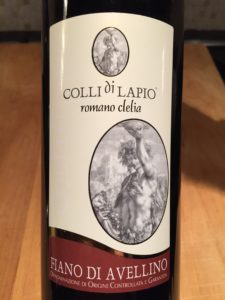 We found the best white wine pairing to be a Fiano di Avellino from Romano Clelia ($30) called Colli di Lapio. The vintage was 2013, but almost any vintage will do as the consistency is superb. Less aromatic than the Viognier, the Fiano excelled in all the other attributes: full-bodied, textured mouthfeel, and a flavorful palate of apricot, melon, Meyer lemon and mineral notes. Importantly, the acidity was moderate yet sufficient to stand up to the full flavors of the sauce and cleanse the palate. The Colli di Lapio delivered finesse and elegance without sacrificing complexity and balance. Perfect. If you cannot find this wine in your area, look for the Fiano produced by Terradoro Di Paolo from the Campo Re vineyard.
We found the best white wine pairing to be a Fiano di Avellino from Romano Clelia ($30) called Colli di Lapio. The vintage was 2013, but almost any vintage will do as the consistency is superb. Less aromatic than the Viognier, the Fiano excelled in all the other attributes: full-bodied, textured mouthfeel, and a flavorful palate of apricot, melon, Meyer lemon and mineral notes. Importantly, the acidity was moderate yet sufficient to stand up to the full flavors of the sauce and cleanse the palate. The Colli di Lapio delivered finesse and elegance without sacrificing complexity and balance. Perfect. If you cannot find this wine in your area, look for the Fiano produced by Terradoro Di Paolo from the Campo Re vineyard.
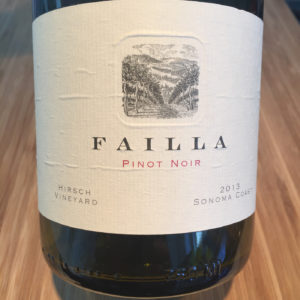 Nothing we’ve written precludes pairing this dish with an excellent Pinot Noir from the Sonoma Coast of California. Our friends, Jen and Andrew, joined us for dinner recently with a 2013 Failla Pinot Noir from the Hirsch Vineyard ($67) in tow. The wine was stellar and the pairing with this dish was excellent but somewhat different: the Pinot found its muse in the grilled salmon, whereas the Fiano made music with the sauce. Two great wines, one excellent, old-school recipe. Bravo Chef Roemer!
Nothing we’ve written precludes pairing this dish with an excellent Pinot Noir from the Sonoma Coast of California. Our friends, Jen and Andrew, joined us for dinner recently with a 2013 Failla Pinot Noir from the Hirsch Vineyard ($67) in tow. The wine was stellar and the pairing with this dish was excellent but somewhat different: the Pinot found its muse in the grilled salmon, whereas the Fiano made music with the sauce. Two great wines, one excellent, old-school recipe. Bravo Chef Roemer!
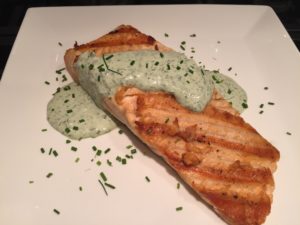
Thomas Lansen says
As usual, my mouth is watering.
Steven says
Thanks for commenting, Thomas. I hope all is well!